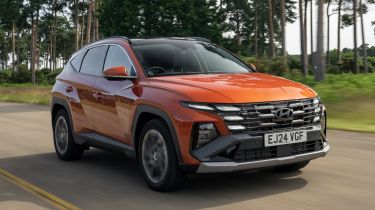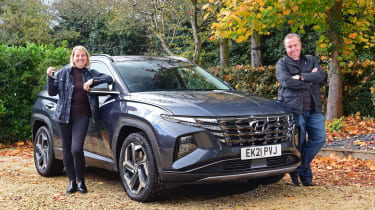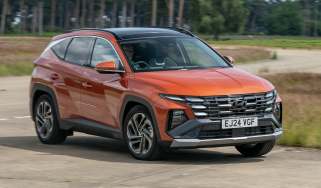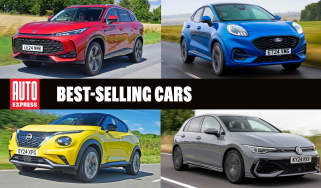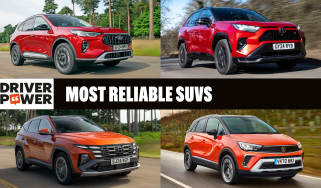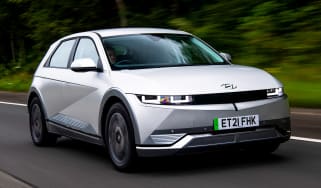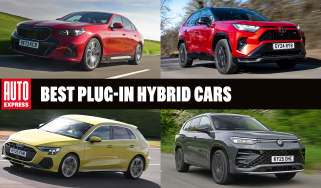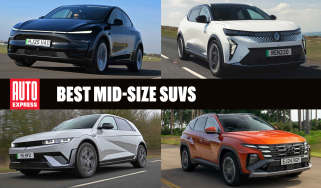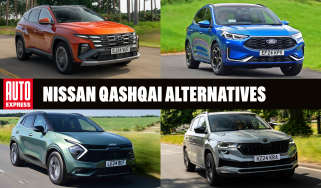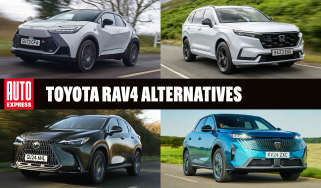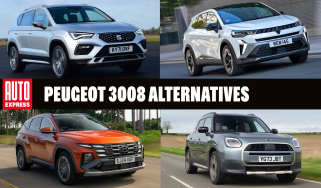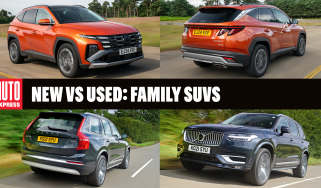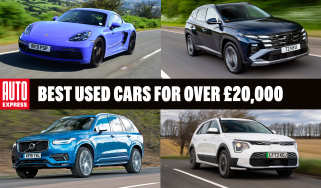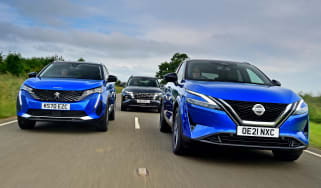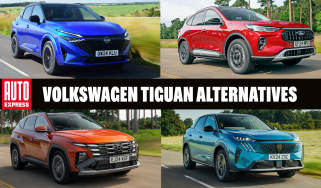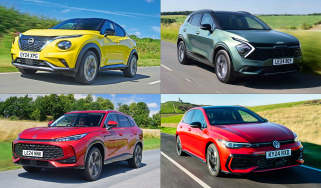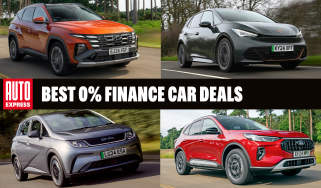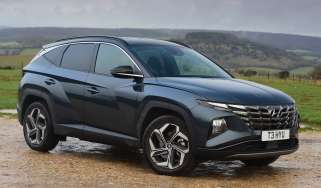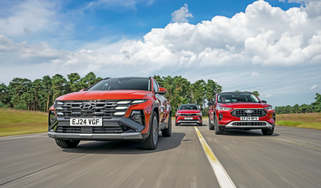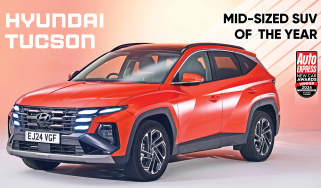Hyundai Tucson review
The Hyundai Tucson combines refinement, space, style and hybrid technology to create a mid-size SUV that’s proving hard to beat

Our opinion on the Hyundai Tucson
The latest Hyundai Tucson means business. Its striking looks, intuitive on-board tech and premium-feeling cabin help it stand out in the overcrowded mid-size SUV class, but the Tucson is a car that appeals to the head as well as to the heart. Efficiency-boosting hybrid technology and high levels of standard equipment can be found throughout the range, while the interior is one of the roomiest in the class and the boot is large enough to rival those of estate cars.
Yes, you’ll find the Tucson a little more expensive to buy now, but we think Hyundai has managed to create a family car that’s as desirable as it is sensible. That’s why we named it our Mid-size SUV of the Year for four years in a row.
| Key specs | |
| Fuel type | Petrol, hybrid, plug-in hybrid |
| Body style | Mid-size SUV |
|
Powertrain
| 1.6-litre, 4cyl, turbo petrol, front-wheel drive 1.6-litre, 4cyl, petrol plus MHEV, front and four-wheel drive 1.6-litre, 4cyl, turbo petrol plus 1x e-motor, front and four-wheel drive 1.6-litre, 4cyl, turbo petrol plus 1x e-motor with 13.8kWh battery, front and four-wheel drive |
| Safety | Five-star Euro NCAP (2021) |
About the Hyundai Tucson
Let’s cut straight to the chase – the previous Tucson was a car that primarily sold itself on practicality, modest pricing and family usability, while decent levels of kit went some way towards making up for its distinct lack of flair.
However, this fourth generation of Hyundai’s mid-size SUV is a different proposition, and keen to establish itself as a premium offering for families that value style and refinement, as well as the more prosaic qualities of overall load space and day-to-day functionality.
Used - available now

2023 Hyundai
Tucson
28,823 milesAutomaticPetrol1.6L
Cash £22,200
2023 Hyundai
Tucson
78,394 milesAutomaticPetrol1.6L
Cash £18,064
2020 Hyundai
Tucson
47,183 milesManualPetrol1.6L
Cash £11,089
2023 Hyundai
Tucson
36,778 milesAutomaticPetrol1.6L
Cash £20,803We’ve pitted the Tucson against multiple contenders over the years, with the Hyundai walking away with the winner’s medal on several occasions. We have no doubt that Hyundai is clearly focused on not only taking on the best of the mainstream, but also nipping at the heels of more upmarket brands like Audi and BMW.
With prices starting from around £33,000, the Tucson range undercuts the Ford Kuga and Volkswagen Tiguan. However, Hyundai doesn’t offer a typical entry-level trim, so you’ll be well catered for in terms of equipment even with the ‘base’ car.
The trim structure is pretty straightforward, starting with Advance before building up to Premium, followed by the sportier-looking N Line and N Line S, before topping out at Ultimate. The standard kit on every model includes dual-zone air-con, cruise control, a rear camera, and a 10.25-inch infotainment touchscreen with sat-nav and Android Auto and Apple CarPlay connectivity.
The N Line models feature sporty tweaks inside and outside, and this trim is Hyundai’s riposte to cars like the VW Tiguan R-Line. You get 19-inch alloys, more aggressive bumpers, twin tailpipes, a tailgate spoiler, and sports front seats. Top-spec cars feature luxuries such as adaptive cruise control, an electric tailgate, a panoramic glass sunroof, heated and ventilated front seats and wireless mobile phone charging.
Power options centre around a 1.6-litre turbocharged petrol engine in various states of tune and with varying degrees of hybrid assistance. You can have a 158bhp petrol-only model with a regular six-speed manual gearbox, or a seven-speed dual-clutch automatic with 48-volt mild-hybrid tech. You can also have a Tucson with mild-hybrid tech which produces the same 158bhp — this can be specced with front- or four-wheel drive but is only available with the seven-speed auto ‘box.
A full-hybrid model is also available, using a 1.49kWh battery and a 59bhp electric motor that works with the petrol engine to produce a total output of 212bhp. The engine options are rounded off with a 249bhp plug-in hybrid version with a pure-electric driving range of 43 miles.
Hyundai Tucson prices and latest deals
How much does the Hyundai Tucson cost? Well, official ‘on the road’ prices range from £32,400 to £41,390 but you can currently save an average of £5,639 through the Auto Express Find A Car service, where prices start at £26,293. You can lease a Hyundai Tucson from £278 per month or buy a used model at prices starting from £10,195.
Check out our latest new car deals, leasing deals and used car deals for the top offers available now on Auto Express. And don't forget we can help you sell your car, too.
Performance & driving experience
|
Pros |
|
| Cons |
|
The fourth-gen Hyundai Tucson uses an all-new platform and advanced hybrid technology – highlighting the manufacturer’s serious aspirations for its latest mid-size SUV.
The hybrid powertrain works well, both at motorway speeds and around town. We noticed that the six-speed automatic transmission is keen to shift up early, but because the engine becomes slightly thrashy when worked hard, that’s not such a bad trait.
You’ll probably want to keep the Tucson in its Eco drive mode most of the time. Choosing the Sport function modifies the throttle response and improves assistance from the electric motor, but it means the car hangs onto lower gears for longer and revs higher, which, ultimately, doesn’t sit well with the Tucson’s focus on comfort.
The hybrid model’s ability to cut engine power when you lift off the throttle at speed not only benefits refinement, but helps boost efficiency, too. It manages this in a particularly smooth and effortless manner, to the extent that you might not even feel the system working at all. The plug-in hybrid Tucson weighs around 200kg more than its conventional petrol or hybrid alternatives, but it’s also the most powerful model in the range. We didn’t find the extra weight had that much of an impact on the way it performs.
Performance, 0-60mph acceleration and top speed
The 158bhp 1.6 TGDi petrol-only model delivers a reasonable 0-62mph time of 9.9 seconds, while upgrading to the mild-hybrid version with a dual-clutch automatic cuts that time down to 9.4 seconds for the two-wheel drive model, or 9.8 seconds for the four-wheel drive. The top speed for all is 119mph.
Full-hybrid tech cranks up the power output to 212bhp and trims the 0-62mph time to 8.2 seconds, although this version has a slightly lower top speed of 116mph. During our testing, we were surprised by how raucous the four-cylinder engine is, and it sounds coarse at high revs.
The plug-in hybrid gets even more power – 249bhp and 304Nm – but it’s much heavier, so 0-62mph is dispatched in 8.2 seconds for the two-wheel drive or 8.5 seconds for the four-wheel drive version, while the top speed stands at 116mph. While the Tucson PHEV won’t win a game of Top Trumps, its electric motor can fill in for the 1.6-litre petrol engine under the bonnet when needed, with all its torque available as soon as you hit the accelerator. As a result, the car surges forward with a willingness unlike any other Tucson.
Town driving, visibility and parking
The Tucson’s light steering makes the Hyundai easy to manoeuvre in town. Opting for the PHEV brings up to 43 miles of pure-electric driving, making this particular model particularly quiet for urban journeys. Whichever Tucson you choose, though, it shouldn’t feel too imposing when facing narrow roads or parking spaces. For a mid-size SUV, it’s pretty easy to place thanks to good all-around visibility. Every model comes with a rearview camera, making parking even easier.
B-road driving and handling
Hyundai has really succeeded in giving the Tucson decent agility through corners while keeping it controlled and composed over the typical broken tarmac of UK roads. You wouldn’t necessarily use the Tucson for a fun Sunday morning blast through country lanes, but it does provide relaxing and refined point-to-point company.
Motorway driving and long-distance comfort
Every Tucson (including the heavier PHEV) does a good job of ironing out bumps, with imperfections in the road being heard more than they’re felt. Accelerating to motorway speeds is a hushed and refined experience for the most part, although the petrol engine’s roar will make itself known when pushed a bit too hard.
| Model | Power | 0-62mph | Top speed |
| 1.6T | 158bhp | 9.9 s | 119mph |
| 1.6 Hybrid | 212bhp | 8.2 s | 116mph |
| 1.6 Plug-In Hybrid | 249bhp | 8.2 s | 116mph |
“At low speeds, the Tucson’s steering is fairly light, and when that’s combined with a low dashboard line relative to the seating position that gives a great view of the road ahead, it’s an easy car to manoeuvre at low speeds.” - Alex Ingram, chief reviewer.
MPG & running costs
|
Pros |
|
| Cons |
|
No matter how well the Hyundai Tucson drives, how comfortable it is to sit in, or how much equipment is crammed on board, if it costs too much to run, it won’t make it onto customer shortlists. Thankfully, the Tucson has a full range of petrol, mild-hybrid, full-hybrid and plug-in hybrid powertrains to suit all budgets and needs – basically everything short of an EV.
The cheapest version to buy is the 158bhp 1.6 T-GDi petrol-only model in Advance trim. It comes with a six-speed manual gearbox and manages a respectable 41.5mpg on the combined cycle, while CO2 emissions are 154g/km.
If you opt for this engine with an automatic transmission, the fuel efficiency improves to 44.8mpg, and emissions drop to 142g/km (40.4mpg and 158g/km for the four-wheel drive version). The improvement over the manual comes because the automatic uses mild-hybrid technology, which gives you a tiny electric motor to provide a little assistance when accelerating and lessen the load on the engine.
The 227bhp full-hybrid model improves on these figures further, with up to 49.6mpg and emitting 129g/km of CO2. We covered over 8,000 miles in our Tucson Hybrid long-term test car, and averaged 46.5mpg during our time with it. We were pretty pleased with that result.
Of course, the most efficient (and most expensive) variant is the Tucson Plug-in Hybrid. According to Hyundai, the Tucson PHEV can return up to 282.5mpg and emits 22g/km of CO2 emissions; and while you might not get close to that in the real world (remember to charge the battery as frequently as possible to minimise your running costs) it should be an affordable family SUV to run.
| Model | MPG | CO2 | Insurance group |
| 1.6T | 41.5 | 154g/km | 18E |
| 1.6 Hybrid | 49.6 | 129g/km | 21E |
| 1.6 Plug-In Hybrid | 201.8 | 29g/km | 23E |
Electric range, battery life and charge time
The Tucson PHEV model is the only hybrid model you need to charge yourself. The rest of the hybrid line-up relies on energy recuperation from braking or the engine to charge their batteries. The Tucson Plug-in Hybrid uses a 13.8kWh lithium-ion battery to offer a WLTP combined pure-electric driving range of up to 43 miles. Although the figure we saw during our own testing was a little lower, you should have no problem covering more than 30 miles without using a drop of petrol if the car is fully charged. That’s good, but the latest Volkswagen Tiguan eHybrid has a claimed electric range of 74 miles thanks to its much larger 25.7kWh (19.7kWh usable) battery.
Unlike the Tiguan eHybrid, the Tucson doesn’t have rapid charging capability, but its 7.2kW on-board charger means you can fully recharge the relatively chunky battery in under two hours if you use a suitably fast home wallbox or public charging point.
| Model | Battery size | Range | Insurance group |
|---|---|---|---|
| Tucson 1.6 Plug-In Hybrid Advance | 13.8kWh | 43 miles | 22E |
Insurance groups
Insurance premiums start from group 18 for the entry-level 158bhp petrol Tucson in Advance trim, which is the same as the base Volkswagen Tiguan.
The 158bhp mild-hybrid variant sits in group 20, while the 212bhp full-hybrid is in group 21. The top-of-the-range 249bhp Tucson Plug-in is a couple of positions higher in group 23, which is lower than the equivalent Tiguan eHybrid, so premiums for the Tucson won’t break the bank.
Tax
The most recent changes to Vehicle Excise Duty (VED) rules mean that all Tucson models, regardless of powertrain, are liable for the standard rate of road tax. Company car buyers will be better off choosing the PHEV as this incurs some Benefit-in-Kind (BiK) tax relief, but fully electric cars still offer the biggest savings. If you want to avoid the luxury car tax, you’ll need to stick towards the lower end of the Tucson line-up and go easy on the options, as this model can surpass the £40,000 mark.
Depreciation
Our expert data suggests that the fourth-generation Hyundai Tucson range will retain between 53 to 56 per cent of its list price after three years and 36,000 miles of ownership. That’s on par with the Nissan Qashqai, but slightly behind the Kia Sportage, which is expected to retain between 51 to 58 per cent of its showroom price over the same period.
To get an accurate valuation on a specific model check out our free car valuation tool...
Interior, design & technology
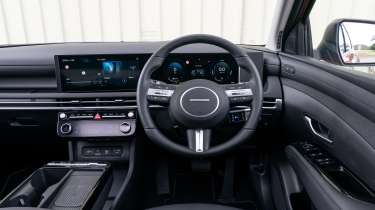
|
Pros |
|
| Cons |
|
When this generation of Hyundai Tucson arrived, it certainly marked a departure from its more conservative forbear to stand out in the highly competitive medium SUV class.
The designers of the revised Tucson have wisely chosen not to tone down its attention-grabbing exterior. The only changes of note are a new grille at the front and a more prominent lower portion of the bumper that includes a faux skid plate to bolster the car’s chunky SUV look. At the back, the Hyundai badge is now behind the glass of the back window, which looks much tidier.
Manufacturers across the board are raising their game when it comes to interior design and levels of onboard tech, and the Tucson is no exception. We were impressed by the premium feel of the interior before, but the design has been dramatically altered with the facelift to give it a look more in keeping with the cabins of the smaller Hyundai Kona and electric Hyundai Ioniq 5.
The digital driver’s instrument cluster and central infotainment screen now flow into one another across the dashboard, while underneath the central screen are a series of physical shortcut buttons that are much easier to get on with compared with the touch-sensitive controls of the pre-facelift car.
Below them are the climate controls, which feature a pair of sizable dials that control the temperature for each front zone, which are much easier to find while driving than the touch-sensitive controls of the outgoing Tucson. The virtual buttons on a screen between the two dials are still touch-sensitive, although you shouldn’t need to interact with them often. The only major downside is that you’ll need to stretch more in order to reach the far corner of the central screen because it’s positioned further away.
Standard equipment is generous, with the entry-level Advance trim including 17-inch alloy wheels, dual-zone climate control, cruise control, a rear-view camera, front and rear parking sensors, heated and folding door mirrors and the usual Bluetooth, wireless smartphone connectivity with a wireless charging pad, and DAB audio set-up.
Upgrading to Premium adds an electric tailgate, an upgraded Krell audio system, a heated steering wheel, heated front and rear seats, along with extra active safety features such as an autonomous emergency braking system that prevents you from turning into the path of oncoming traffic at a junction, and adaptive cruise control to automatic and hybrid models
N Line and N Line S models introduce a few sporty touches to the fourth-generation Tucson, both inside and out. The standard N Line mirrors much of what you get with Advance, but adds 19-inch alloy wheels, a reprofiled front bumper with larger intakes and a more aggressive rear diffuser with twin-exit exhausts. Buyers also get a tailgate spoiler and a fresh radiator grille, plus an N-branded steering wheel, black headlining, aluminium pedals and a pair of sports seats trimmed in black suede and leather for the cabin.
N Line S trim gets the same styling tweaks, but extends the kit list to include three-zone climate control, a heated steering wheel, ventilated front seats, an electric panoramic sunroof, a 360-degree camera system, LED matrix headlights, as well as a Blind Spot Collision Warning system.
Those who don't want a sporty-looking Tucson but want the gadgets fitted to N Line S will need to go for the top Ultimate trim, which adds driver’s seat memory settings and the availability of alternative seat colours.
Interior and dashboard design
Once you’re sitting in the driver’s seat, you’re faced with a smart 10.25-inch digital instrument cluster and a clean, simple layout with only a few physical buttons and switches. Cars with a manual gearbox have a different centre console design, while automatic models follow the aforementioned Kona and Ioniq 5 in using a gear selector mounted just behind the steering wheel on the right, freeing up more storage space.
Materials and build quality
The solid feel of the pre-facelift Tucson carries through to the revised model, although our previous note of a sombre colour palette for most trim levels remains, despite the odd strip of fabric across the dash to break up the expanse of soft-touch plastic.

Infotainment, sat-nav and stereo
The Tucson has a very impressive infotainment system that’s intuitive and straightforward to operate. Every model features a pair of 10.25-inch screens that offer fast loading times and clear graphics, plus built-in sat-nav (which works well), along with Apple CarPlay and Android Auto if you would prefer to link up your smartphone.
The central touchscreen might not match the display sharpness or loading times of the Renault Austral’s Google-powered set-up, nor is it as big as the one in the Kia Sportage, but it’s still clear and easy to read. The main menu displays all of the key features in two rows of shortcut icons, and most of the sub-menus are fairly well thought out.
Hyundai has improved navigation to the driver-assistance menu, which is a blessing considering that the car can seem like it’s beeping at you incessantly as you’re driving along. You used to have to delve into various menus within the touchscreen, but now there’s a shortcut button on the steering wheel that sends you straight to the correct menu. There’s also a secret shortcut to deactivate the speed limit warning (a system that beeps when it detects you’re exceeding the speed limit) where you simply press the mute button for a few seconds to silence the system.
A second 10.25-inch display sits ahead of the driver. The stats are easy to select via steering wheel-mounted buttons, and the colours and graphics adjust based on the chosen driving mode.
If you enjoy listening to music in your car, the upgraded Krell stereo available with Premium, N Line S, and Ultimate trims is worth considering.
“The latest Tucson’s cabin is worlds apart from any of its predecessors, and it manages to outshine numerous competitors while it’s at it. Much like the exterior, this interior design would genuinely be at home in a far pricier model due to the consistently high standard of materials, tech and build quality throughout.” - Shane Wilkinson, senior content editor.
Boot space & practicality
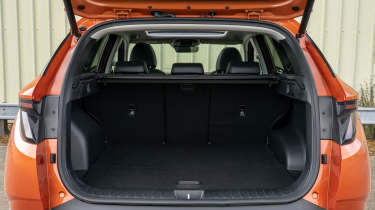
|
Pros |
|
| Cons |
|
Passengers won’t be disappointed with the amount of interior space offered in the Hyundai Tucson. The driver’s seat and steering wheel have plenty of adjustment for rake and reach.
Hyundai has added a lot of features, even to entry-level cars, to make the Tucson a truly versatile family SUV. The rear seats fold in a 40:20:40 configuration, while there are front and rear armrests with cupholders and extra storage for assorted oddments. You’ll also find useful USB ports front and back, along with standard parking sensors and a rear-view camera.
If you want to pay for it, higher trim levels have luxuries such as an electrically operated tailgate, three-zone climate control and heated and ventilated seats to make longer journeys that bit more comfortable.
| Dimensions | |
| Length | 4,520mm |
| Width | 1,865mm |
| Height | 1,650mm |
| Number of seats | 5 |
| Boot space | 620-1,799 litres (577-1,651-litres Hybrid & Plug-in Hybrid) |
Dimensions and size
The Hyundai Tucson measures 4,520mm in length, 1,865mm wide (excluding door mirrors), and 1,650mm tall. As a comparison, the Volkswagen Tiguan is longer at 4,539mm, although the Tucson is 8mm wider.
Driving position, seats & space in the front
The latest Tucson’s wheelbase is only marginally longer than the previous model’s, but Hyundai has been clever with the car’s packaging to ensure that the cabin can easily accommodate two tall front passengers.
There’s plenty of headroom, even with a panoramic roof thrown into the equation. However, those who prefer a memory setting in their driver’s seat will have to fork out on the range-topping Ultimate trim.
Seats & space in the back
It’s a similar story for rear passengers because, once again, taller occupants won’t be left wanting for room to stretch out in. There is also space for a third rear passenger, but the raised central floor prevents them from finding a truly comfortable position. The seats themselves are supportive, though, and there’s plenty of space under the front seats for the rear passengers’ feet.
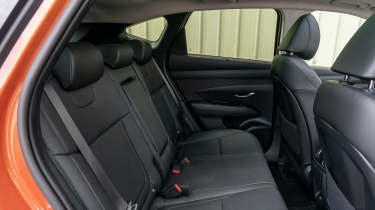
Boot space
The Hyundai Tucson offers 620-litres boot space in petrol manual form with the seats up, expanding to 1,799-litres with the seats down, which makes it family-friendly. That's around 30 litres more than you get in a Kia Sportage and a whopping 116-litres more than the Nissan Qashqai can manage.
However, it’s worth noting that both hybrid and plug-in hybrid Tucson models have a reduced boot capacity of 577-litres with the seats up, and 1,651-litres with the seats folded, although that’s still much better than a plug-in eHybrid Volkswagen Tiguan, which only has 490 and 1,486 litres of capacity respectively.
We think a few more hooks and individual storage compartments would be helpful, but overall, the space and flat floor should be fine for most day-to-day needs. The Tucson also has a modest amount of under-floor boot storage, which is always handy.
Towing
The Hyundai Tucson has varying braked towing capacities depending on your chosen powertrain. The weakest of the range are the PHEV models, but these can still lug a reasonable 1,210kg. The full-hybrids are a bit stronger at 1,360kg, while the mild-hybrid and pure-petrol cars can take on 1,510kg.
“There aren’t many cars in this class that come close to matching the Tucson’s cavernous boot. The load lip is fairly high – especially when compared with the Kuga’s – but at least the bumper isn’t deep.” - Alex Ingram, chief reviewer.
Reliability & safety
|
Pros |
|
| Cons |
|
The electrified powertrains used in the Hyundai Tucson are widely used in other Hyundai models, so the Tucson should prove to be a reliable family SUV. The fourth-generation model scored a respectable 13th place out of 50 cars in the 2025 Driver Power customer satisfaction survey, too, which was miles ahead of its sister car, the Kia Sportage, which finished in 45th place in our best car to own rankings. The Kia does have an advantage in the warranty stakes, though, with seven years included, whereas Hyundai only manages five years.
The Tucson's standard safety kit is good, although to benefit from the full suite of active systems, you’ll need to upgrade to N-Line S or Ultimate trim. Both of these include a Blind Spot Collision Warning, Forward Collision Avoidance Assist, and Rear Cross Traffic Collision Avoidance, which help you avoid any potential hazards as you reverse out of a driveway or parking spot.
Crash safety experts Euro NCAP awarded the fourth-generation Tucson a full five-star rating when it tested the family SUV in 2022. It received an 86 per cent score for adult occupant protection and 87 per cent for child occupants, although protection of the driver's chest was assessed as being only marginal.
| Key standard safety features |
|
| Euro NCAP safety ratings |
|
Buying and owning
Best buy: Hyundai Tucson Hybrid Advance
The Tucson offers good value for money, but it can be a tad expensive to buy if you move up the range. Stick with the entry-level Advance trim, though, and you’ll get a decent helping of useful kit without forking out a fortune (you’ll avoid the luxury car tax, too).
Add the full-hybrid powertrain to this mix and you’ll save a pretty penny on running costs, too, without the need to plug-in.
Hyundai Tucson alternatives
Simply put, the mid-size SUV market is massive, so there’s plenty of competition for the Tucson to face. Closest to home is the Kia Sportage, which shares the same underpinnings as the Hyundai. Elsewhere, the Ford Kuga, Nissan Qashqai, Skoda Karoq, Mazda CX-5, Vauxhall Grandland, Renault Austral and Volkswagen Tiguan are just some of the seemingly endless rivals to choose from.
Latest deals on the Tucson and rivals
Hyundai Tucson Ultimate hybrid: long-term test
In 2021, our former editor Steve Fowler ran a top-of-the-range Ultimate trim Hyundai Tucson for 8,000 miles. They (including their goldendoodle) were all won over by an extensive equipment list, lots of interior space, and - of course - its styling.
The family took the Tucson far and wide across the country on their summer holiday, managing mid-40s fuel economy and making full use of its Highway Driving Assist system.
You can read the full Hyundai Tucson long-term test here…
Frequently Asked Questions
The Hyundai Tucson is a stylish, refined and incredibly practical car, not to mention the winner of several Auto Express Mid-size SUV of the Year awards.
New & used Hyundai Tucson deals

